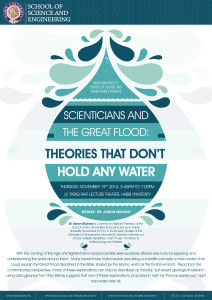By Anusha Aijaz
(Student, School of Arts, Humanities and Social Sciences, Habib University)
Dr. Aaron Mulvany holds Ph.D. in South Asian Studies from the University of Pennsylvania. His interests include music, anthropology, folklore, and history. He is the assistant professor of Social Development and Policy.
Dr. Aaron gave a lecture on water-related disasters, which is the field he holds great expertise in. He gave the whirlwind tour of the scientific (and pseudo-scientific) discourses on the Great Flood. The Great Flood, or Toofan-e-Nooh (literally: the Storm of Noah) as it is known in Islamic cosmology, was a supposedly universal disaster in which all of humankind, except for a few divinely selected individuals, was destroyed.
https://vimeo.com/148855629
He initiated the talk by explaining the history of flood, and speaking about various Christian cosmologists and theologians. He discussed how the world was understood to be divided between the concept of heavens and earth, and why scholars believed that flood is a universal event rather than a localized one. Then he took the discussion forward by unfolding different theories of 17th Century scholars. Dr. Aaron introduced Telluris Theoria Sacra – the Sacred Theory of the Earth – authored by Thomas Burnet, as a seminal work in ‘scientific’ explanations of the Great Flood.
He explained that in Burnet’s book, he has argued that the crust of the earth is smooth and is surrounded by a hollow cavity that contains an ‘abyss’ of water. A number of factors are responsible for the cracking of this smooth surface during the flood, thus allowing the flood of water from the abyss to cover the earth to a ‘depth of 15 cubits’.
Various counter statements and criticisms to Burnet’s work by different scholars were presented by Dr. Mulvany. In addition, he also pointed out faults of Burnet’s module as a work of speculative cosmogony rather than the result of first hand observations of actual phenomena.
Then Dr. Aaron turned the discussion by revealing that most of the explanations given by Burnet can only be regarded as bizarre. Latest geological research suggests that one of them might hold water. To explain his point better, he referred to a recent scientific discovery which describes ‘oceans of water’ trapped in a mineral known as ringwoodite deep beneath Earth’s mantle. This discovery reflects Burnet’s theory of the existence of an ‘abyss’ of water under the surface of the Earth, which – according to Burnet – had cracked open and spilled out onto the surface, resulting in the Great Flood.
The talk was very informative and interesting. It also helped in understanding how natural sciences and the social sciences sometimes find common ground despite their seemingly obvious divergences.

